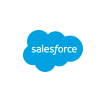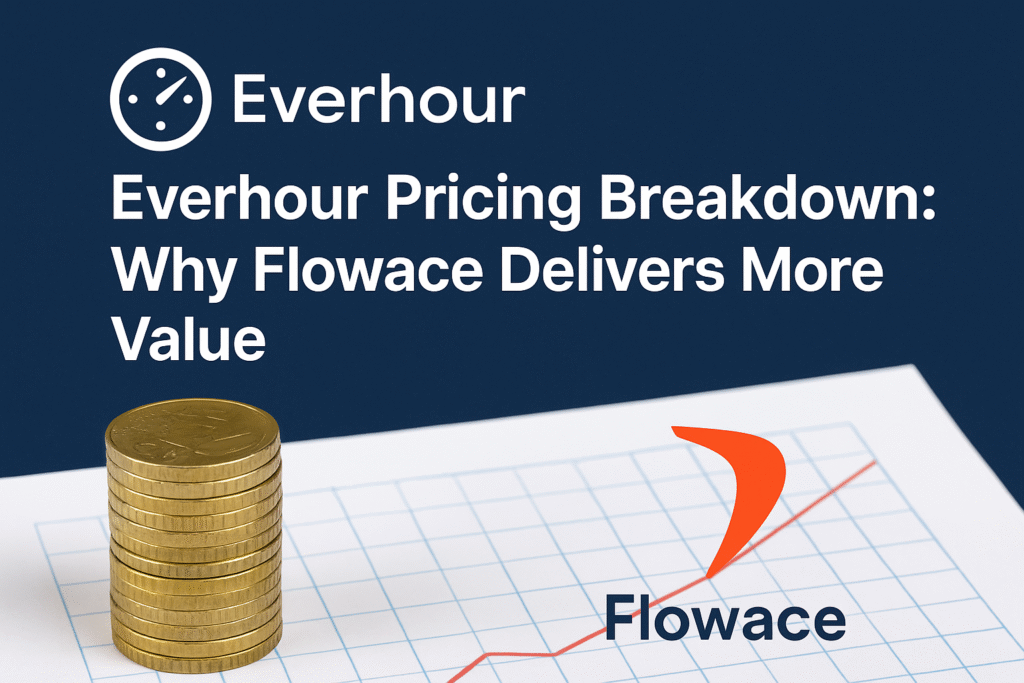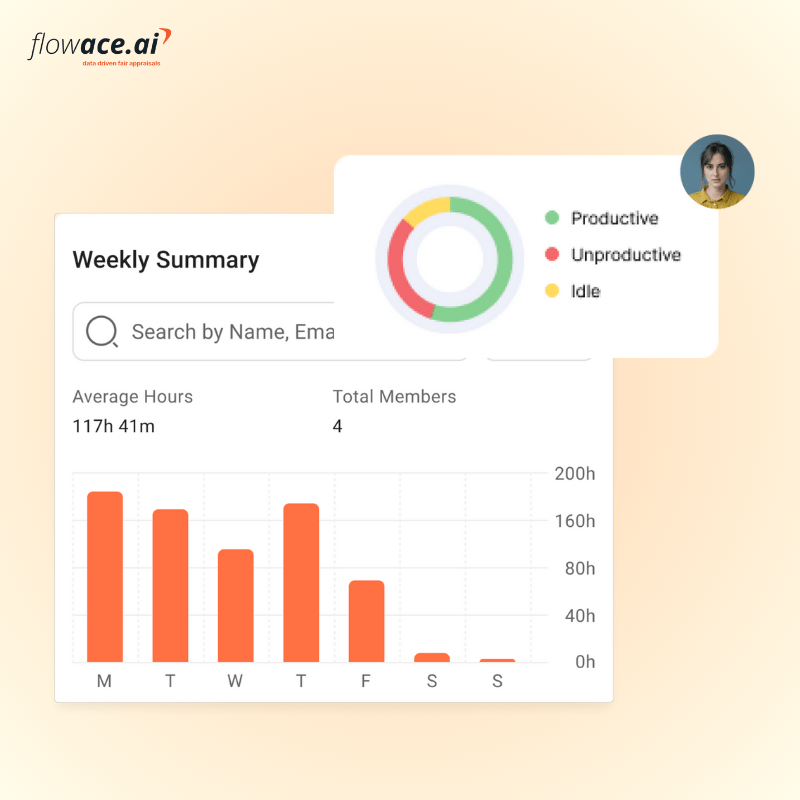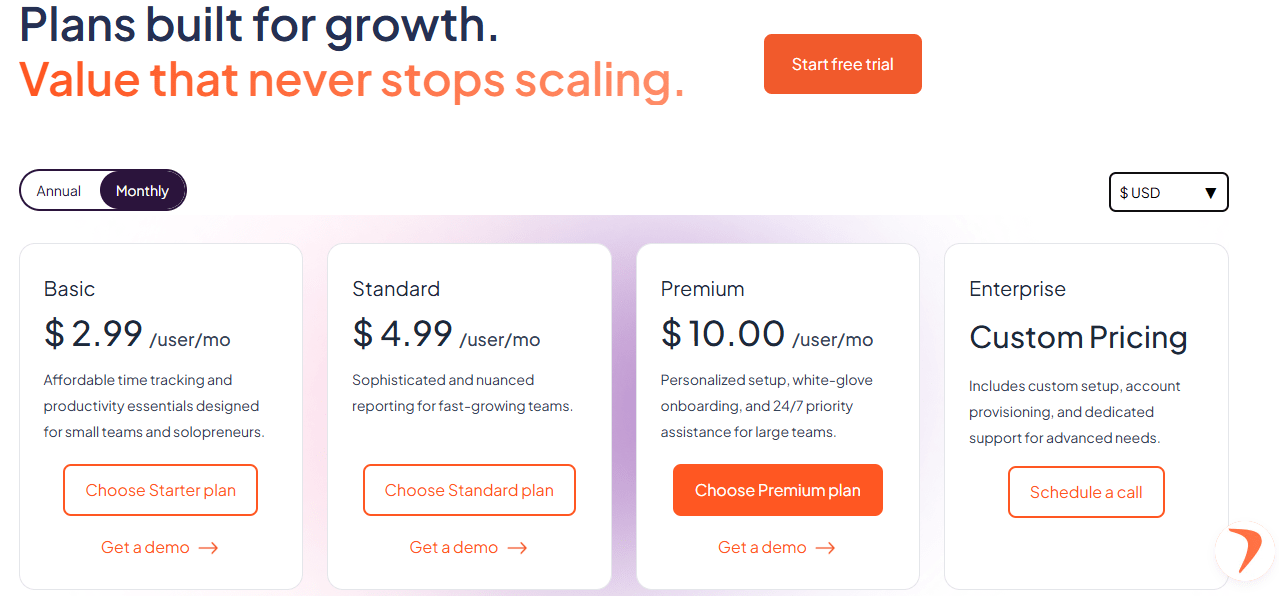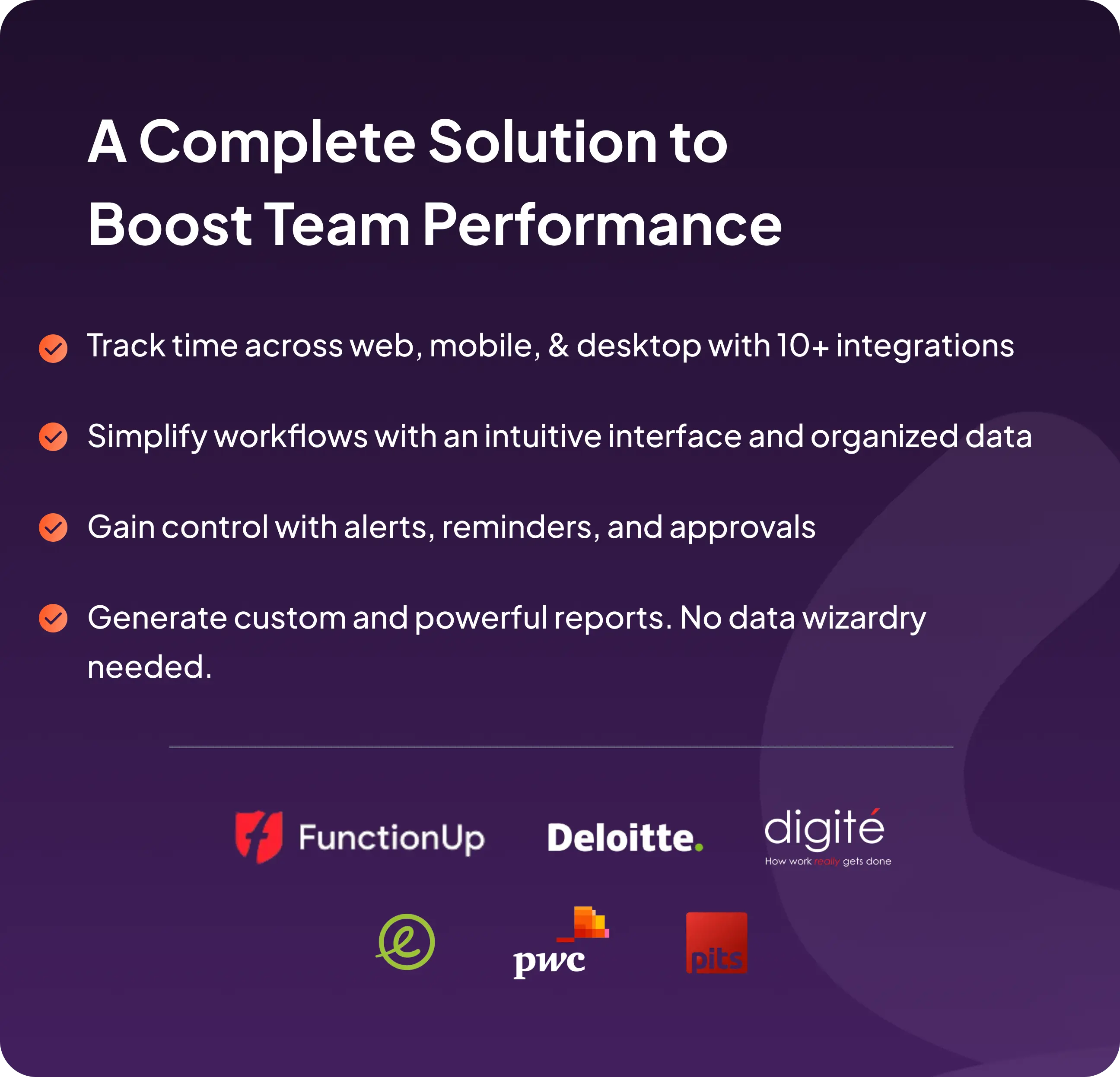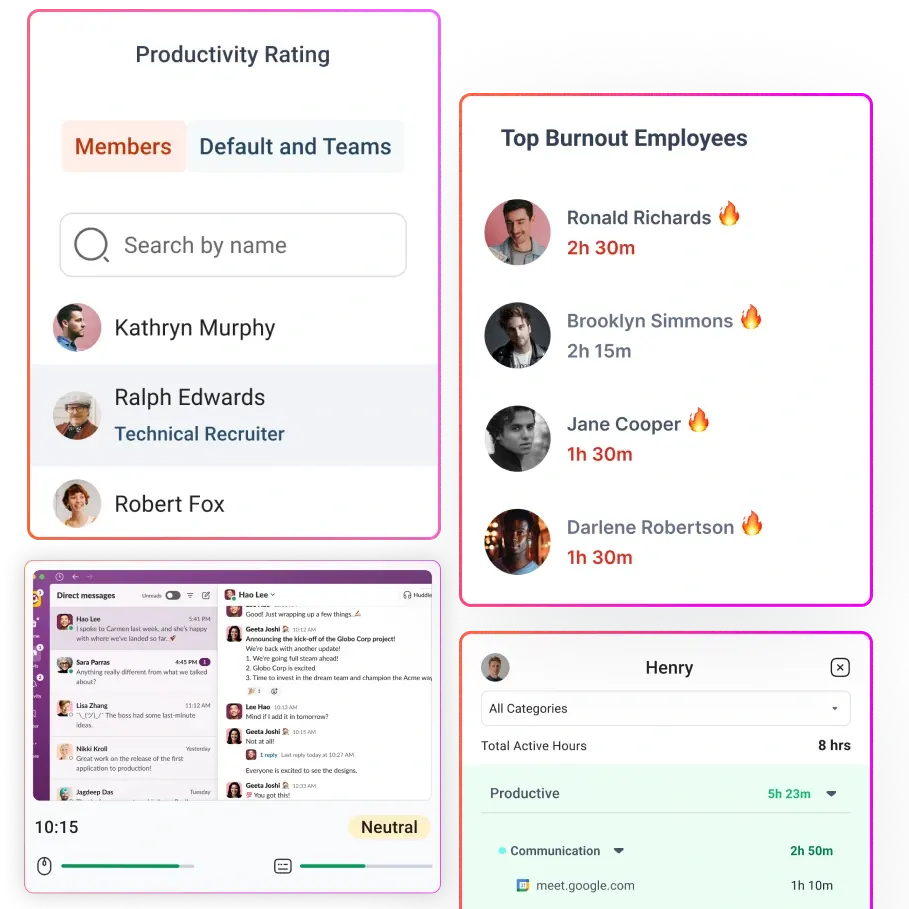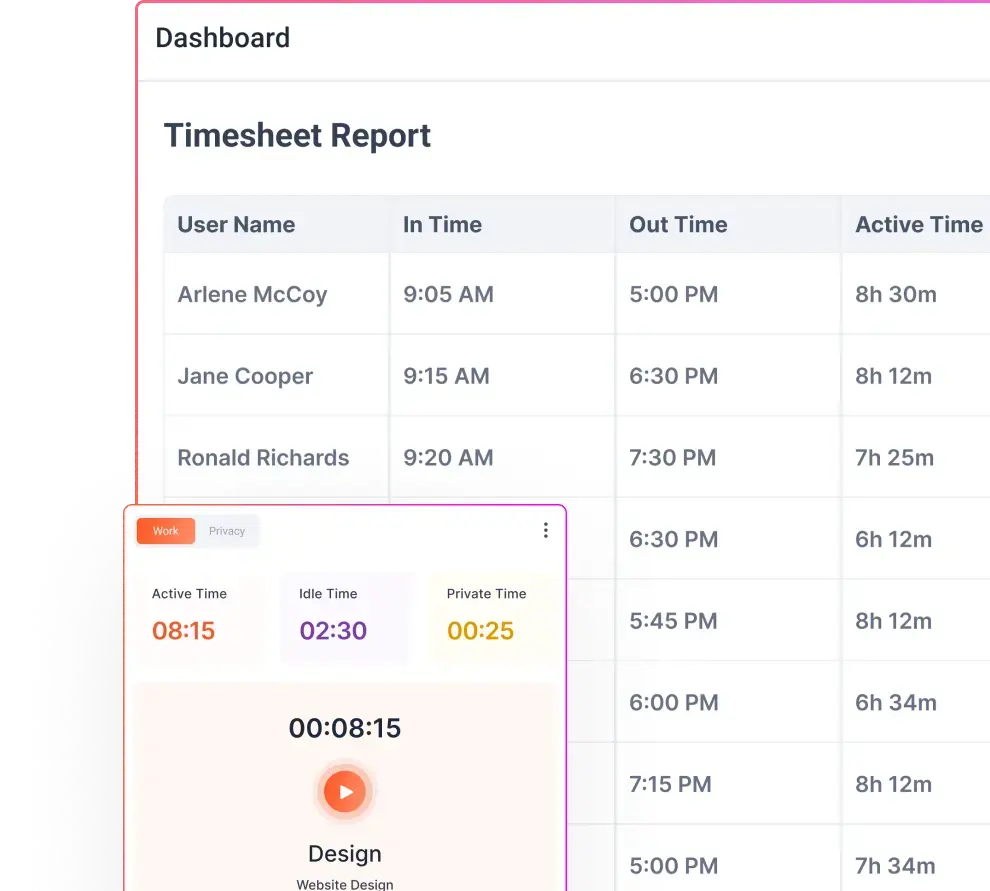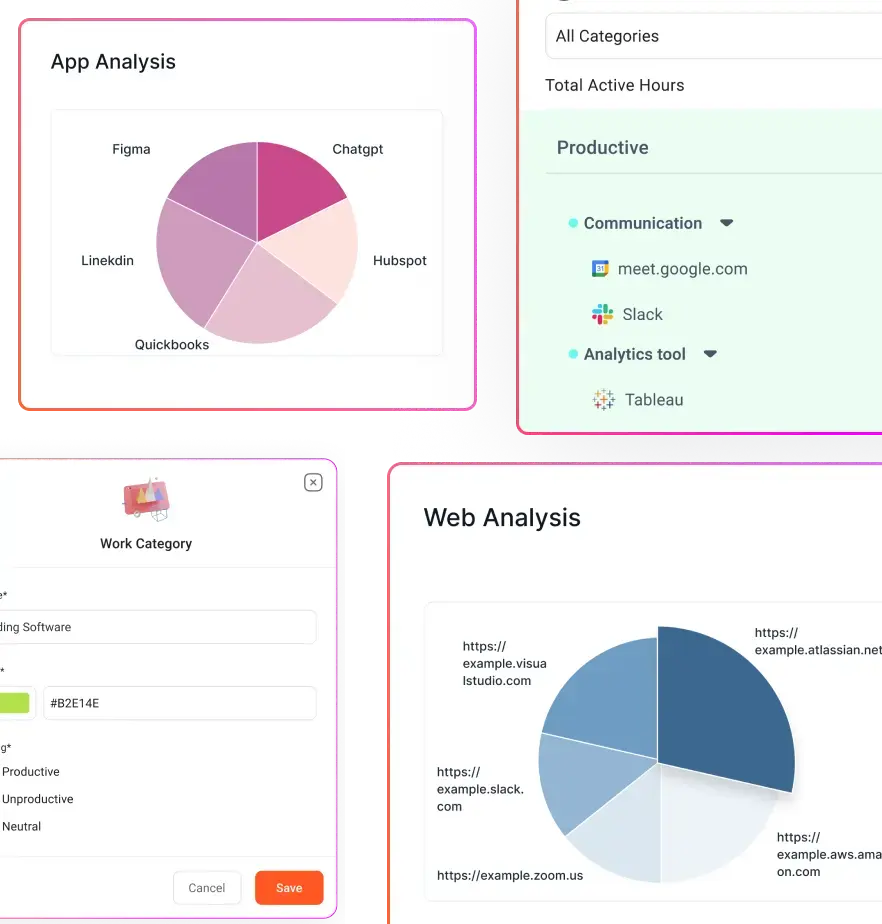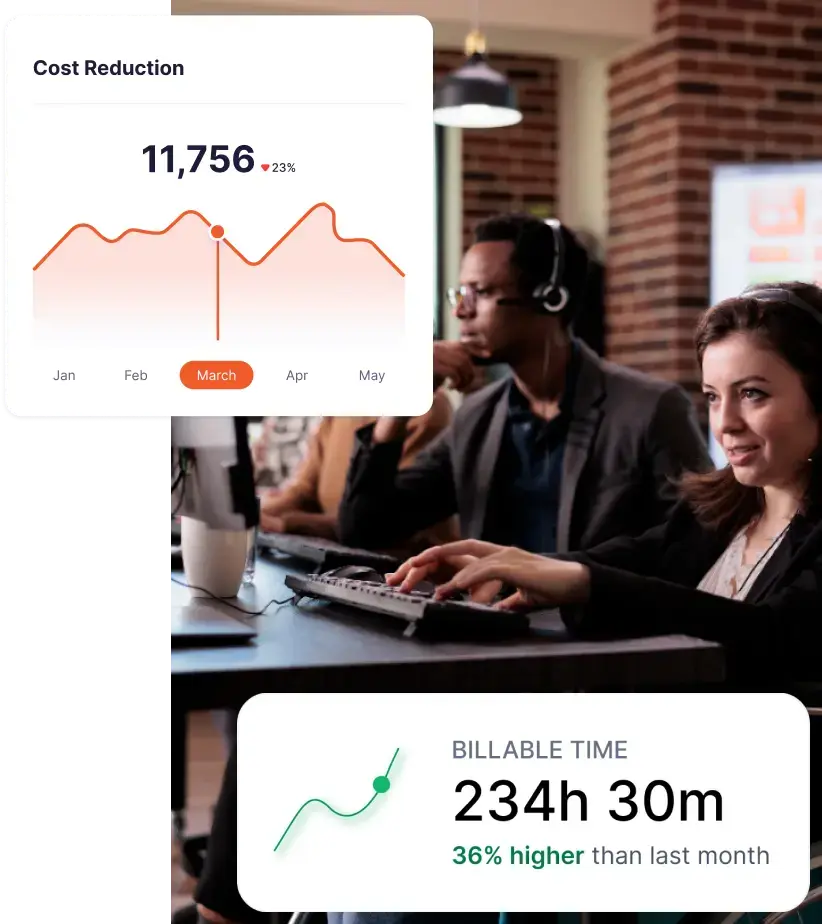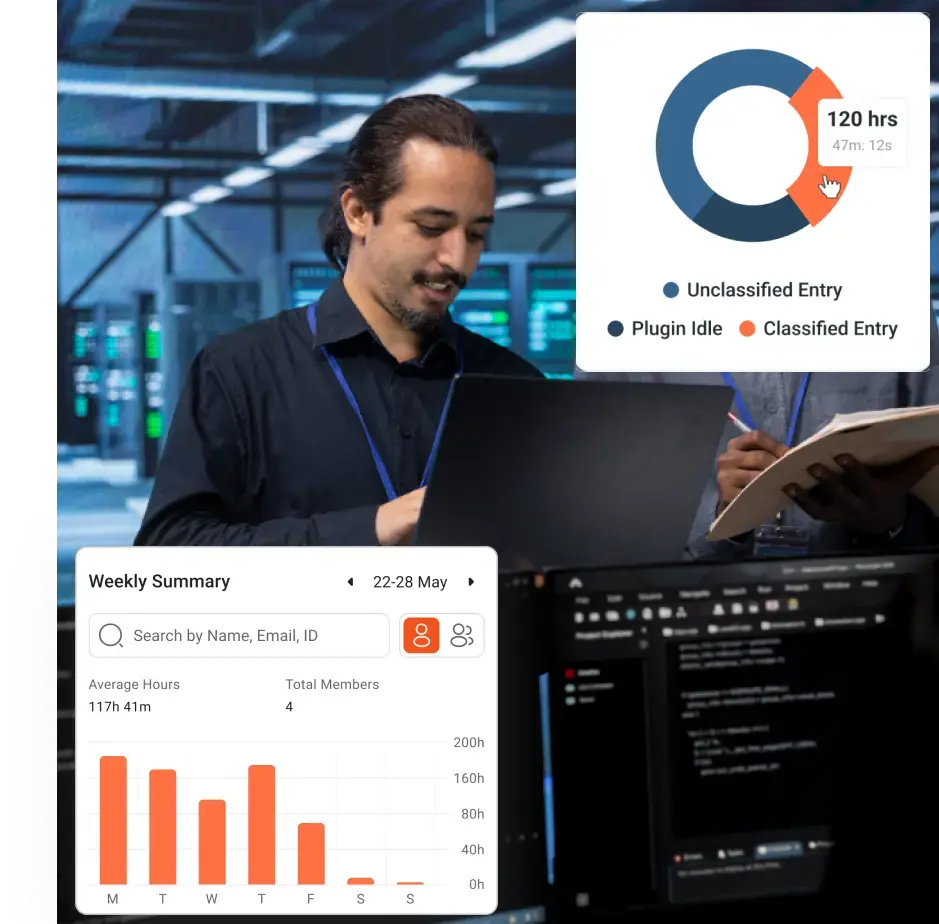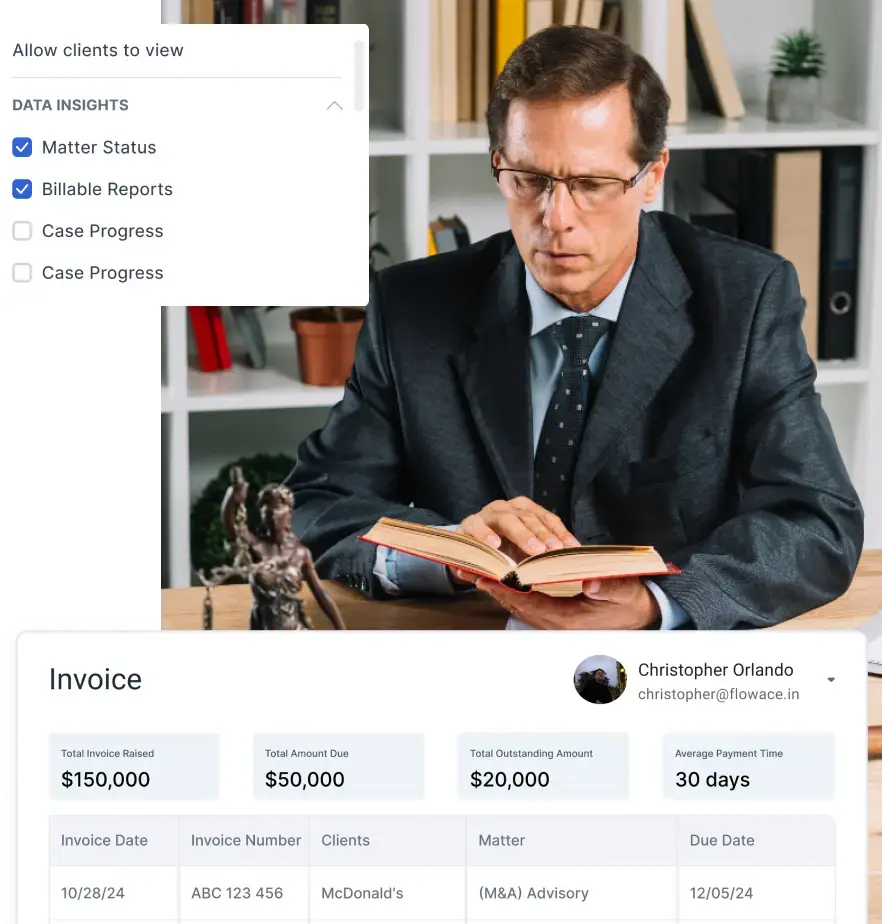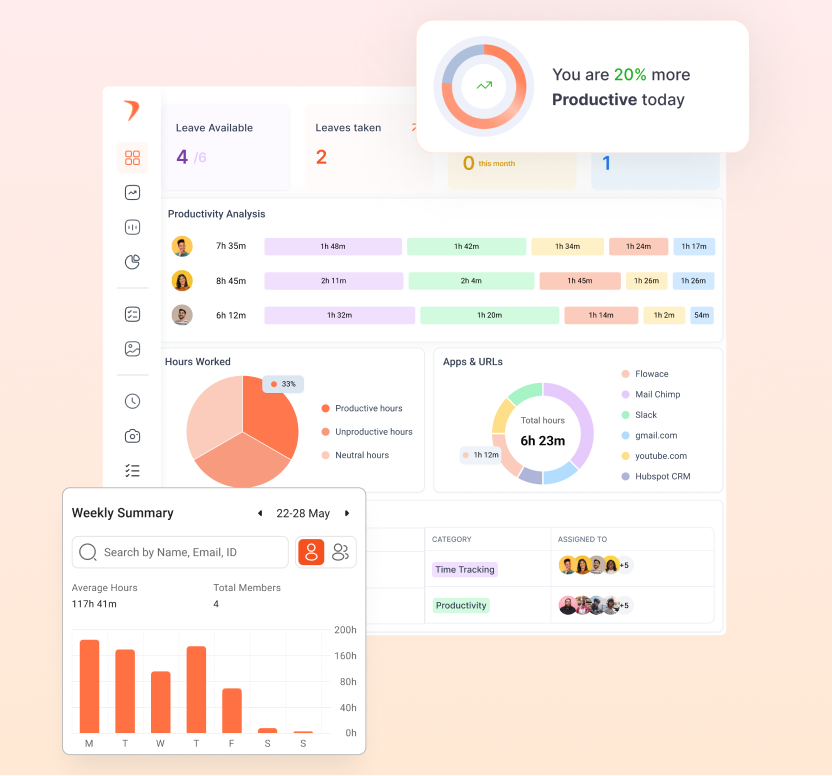Key Takeaways:
-
Everhour is great for service-based teams: It works well for agencies, consultants, and freelancers who need precise time tracking and easy invoicing integrations.
-
Everhour pricing may not suit small teams: The free plan is limited, and the paid plan’s 5-user minimum can make it expensive for smaller groups.
-
Its integrations are strong but not flawless: While Everhour connects easily with tools like Asana and Jira, users have reported occasional sync issues and interface limitations.
-
Flowace offers more flexibility at a lower cost: Starting at just $2 per user/month, Flowace has no seat minimum and provides automated tracking, analytics, and monitoring features.
-
Automation gives Flowace an edge: Flowace automatically tracks time and activity in the background, unlike Everhour’s manual timers—saving teams hours of admin work. Start your free trial today to see Flowace in action.
When choosing a time tracking tool for your team, cost and features are usually at the top of your mind. If you’ve been looking into Everhour, you might be curious not only about Everhour pricing but also how it stacks up against alternatives like Flowace.
Both Everhour and Flowace help you track time, manage projects, and boost productivity. But they take different approaches, and their pricing is different too. So in this article, we’ll break it all down for you.
You’ll get a clear look at what Everhour offers, how much it costs, and what features come with each plan. Then we’ll compare that to Flowace and see how the two stack up.
When would Everhour be the right choice for you?
Everhour would be the right choice for:
- Agency and Consulting Work: Everhour excels for service-based businesses that bill clients hourly and need precise project tracking.
- Freelancers and Small Consultancies: Independent professionals and small teams appreciate Everhour’s straightforward billing workflow that converts tracked time into invoices with minimal manual work.
- Teams Using Popular Project Management Tools: Organizations already invested in Asana, Trello, Jira, Basecamp, or similar tools benefit from Everhour’s deep native integrations.
Everhour Pricing Plans Overview
Let’s take a closer look at Everhour pricing and see what each plan offers for different types of teams. Everhour pricing plans include: a Free plan and a Team (Paid) plan
-
Everhour’s Free Plan supports up to 5 users and includes basic time tracking and reporting but lacks integrations with tools like Asana or Trello—making it suitable only for individuals or very small teams.
-
The Team Plan starts at $8.50–$10/user/month (with a 5-user minimum), offering full features like project integrations, invoicing, budgeting, SSO, and expense tracking—ideal for client-based teams but potentially expensive for smaller groups.
Why Everhour is Just Not Enough?
One of Everhour’s strengths is its simple and clear interface. Time entries, reports, and dashboards are straightforward, making it easy to stay on top of things.
That said, there are some downsides to Everhour’s pricing model.
The jump from the free plan to the paid plan can feel steep. One of the most common critiques about Everhour pricing is the lack of flexibility for small teams due to its 5-seat minimum requirement. There’s no middle-tier option, so smaller teams that outgrow the free plan might end up paying for features they don’t need.
Users generally appreciate Everhour’s easy integrations, especially when tracking time in tools like Asana or Jira without switching apps. However, some users have pointed out a few issues. For example, there have been complaints about inaccurate time reporting across different time zones, which caused problems for distributed teams. Everhour’s suggested fix was adjusting the computer’s time zone, but that wasn’t ideal.
Some users also feel that Everhour’s user interface could be more visually intuitive. There are also occasional hiccups with integrations, where connections to tools like ClickUp or Google Calendar might disconnect and require re-authentication.
While its pricing is clear, the lack of flexibility with plans and the minimum seat requirement might not be ideal for all teams.
If Everhour’s limitations have you second-guessing, Flowace could be a smarter alternative.
Let’s look at Flowace’s pricing and see how it compares with Everhour. You might be surprised at the differences.
Flowace Pricing & How We Compare
Now that we’ve broken down Everhour pricing, let’s explore how Flowace stacks up in terms of features and cost-effectiveness.
Flowace is positioned as the best time tracking software that can serve as an Everhour alternative (among others). Unlike Everhour’s two-plan approach, Flowace offers three paid plans to choose from: Basic, Standard, and Premium. They do offer a free 7-day trial for new users to test all their features before making a choice.
The emphasis with Flowace is on providing a lot of value at a lower cost, and the pricing reflects that. Let’s break down Flowace’s pricing.
Flowace Basic
Flowace’s entry-level plan starts at about $3 per user per month if billed monthly or $2 per user per month with annual billing. It’s a great option for small teams since there’s no cap on the number of users—you pay only for active users. Even though it’s the “Basic” plan, it’s packed with features.
Here’s what you get:
- Unlimited projects and tasks
- Team and individual dashboards
- Silent tracking (automatic time tracking that runs in the background)
- Unlimited screenshot capture
- Activity level tracking
- Work-life balance metrics to help prevent burnout
Flowace Standard (Most Popular)
The Standard plan costs about $5 per user per month with monthly billing, or $4 per user per month if paid annually. It includes everything in the Basic plan, plus a lot of useful upgrades.
Here’s what’s new in Standard:
- 10+ integrations with project management tools like Jira and Asana
- Advanced productivity features, including productivity ratings (which score how productive an employee is based on their computer usage)
- Inactivity alerts for when someone goes idle for too long
- Detailed web and app usage reports
- Daily and real-time email notifications with summary reports and alerts
- A few sessions with a product specialist to help your team get the most out of the software
Flowace Premium
The Premium plan is $10 per user per month with monthly billing or around $7 per user per month if you pay annually. This is the top-tier plan, designed for teams with advanced needs or larger organizations.
Premium includes everything in the Standard plan, plus:
- Client login access, so you can let clients view specific dashboards or reports (great for agencies)
- An executive dashboard for high-level productivity overviews
- Automatic user provisioning for easy user management
- A dedicated account manager for priority support
- Internet connectivity reporting and keyboard/mouse activity tracking for deeper insights into employee activity.
Flowace Custom Pricing
Flowace offers a custom Enterprise pricing plan tailored to meet the specific needs of large organizations or those with unique requirements. This plan provides flexibility and scalability beyond the standard offerings. It includes:
-
Advanced Monitoring Capabilities: Includes keyboard and mouse activity tracking, internet connectivity reporting, and hybrid work analytics.
-
Enhanced Security and Access Control: Supports Single Sign-On (SSO) and auto-user provisioning for seamless integration with existing systems.
-
Dedicated Support: Provides a dedicated account manager and VIP support to assist with implementation and ongoing needs.
-
Customization and Integration: Offers custom integrations and the ability to white-label the platform to align with your organization’s branding.
-
Deployment Flexibility: Supports on-premise setup for organizations with specific data security requirements.
-
Scalability: Allows for unlimited job sites and hierarchical task levels, accommodating complex organizational structures.
Pricing for this plan is customized based on the organization’s size, requirements, and deployment preferences. To obtain a personalized quote, contact us today.
Why Flowace Is a Better Deal
Flowace’s pricing is much lower than Everhour’s, even for the Premium plan. At $10 per user (monthly), Flowace Premium offers more advanced monitoring features, like client access and keyboard/mouse tracking, compared to Everhour’s Team plan. Plus, Flowace doesn’t require a minimum number of users.
For example, if you have a 4-person team that needs integrations, you’ll pay approximately $20 per month with Flowace’s Standard plan. With Everhour, you’d have to pay for 5 users, costing you around $50 per month. That’s more than double the cost, just because of Everhour’s seat requirements.
One of Flowace’s key strengths is its productivity analytics. It tracks time but also helps analyze it. It shows which apps or websites are productive, how much idle time occurs, and gives a “productivity score” for each person or team. This can help identify bottlenecks or distractions. Flowace even supports call tracking, like syncing with WhatsApp calls or GPS-based tracking, which is unique.
In comparison, Everhour focuses more on project metrics like budgets and billable hours. Flowace offers these advanced features at a more affordable price point. Users often mention that Flowace provides “enhanced features at an affordable price.”
In short, Flowace gives you flexibility and features at a much lower cost, perfect for small teams who want more for less.
Flowace vs Everhour: Side-by-Side Feature Comparison
| Feature/Capability | Everhour | Flowace |
| Time Tracking Method | Manual start/stop timers, or enter time manually. | Automatic background tracking + manual timers. |
| Native Integrations | Yes (Asana, Trello, Jira, etc.) on paid plans. | Yes (Jira, Salesforce, Asana, etc.) on Standard+ plans. |
| Project & Task Management | Projects and tasks in paid plans. | Unlimited projects/tasks, multi-level structure. |
| Screenshots Monitoring | Optional in paid plans. | Unlimited screenshots in all plans. |
| Idle Time Detection & Alerts | Auto-stop timer, no active alerts. | Inactivity alerts, pause tracking, and idle time capture. |
| Productivity Analysis | Basic time reports, no app categorization. | Advanced analytics, productivity ratings, app/website usage. |
| Budgeting & Expense Tracking | Yes, with alerts on the Team plan. | Yes, project budgeting and cost tracking. |
| Invoicing | Yes, integrates with QuickBooks/Xero for invoicing. | Partial data export for invoicing. |
| User Management & Security | Team roles, SSO on paid plans, and time approval. | Teams/groups, SSO, client login in Premium. |
| Customer Support | Knowledge base, email support. | Onboarding help, training sessions, dedicated manager on Premium. |
| Free Trial | 14-day trial, no credit card required. | 7-day trial, no credit card required, live demo available. |
This table clearly highlights the main differences between Everhour and Flowace. Everhour and Flowace have overlapping capabilities in core time tracking and reporting, but Flowace tends to pack in more automated monitoring and productivity analysis features, whereas Everhour focuses on integrations and project financials.
Try Flowace: A Smarter Alternative to Everhour
It’s clear that while Everhour is a solid time tracking software, Flowace emerges as a smarter alternative compared to Everhour pricing and features. With Flowace, you’re looking at a tool that not only tracks time but actively helps improve how your team works, all while saving you money. It combines time tracking with employee monitoring and productivity improvement in one package.
If you’ve been examining Everhour pricing and feeling unsure if it’s the right investment, it might be time to give Flowace a try.
Based on our research, here are some key reasons why Flowace can be a better choice:
- Better Value for Money: Flowace is much more affordable than Everhour for similar functionality. For about half the price, Flowace Standard offers integrations and advanced features you’d get in Everhour’s $10 plan. Plus, Flowace has no minimum user requirement, so small teams can pay only for what they use.
- Fully Automated Time Tracking: Flowace automates time tracking in the background, so no more manually starting and stopping timers. It logs activity on apps, websites, and meetings, making it effortless. Everhour still requires manual input or starting timers, which can lead to missed hours.
- Richer Productivity Insights: Flowace gives detailed reports on time spent, app usage, and even idle time. It also offers productivity scores and alerts for unproductive activity. Everhour focuses more on project reports but lacks the in-depth workload analysis that Flowace provides.
- Flexibility and Scalability: Flowace offers three plan options and add-ons to suit your needs. Whether you’re a small team or a large enterprise, Flowace can scale with you. Everhour’s all-or-nothing approach can be limiting as your needs evolve.
- No Seat Limitations for Small Teams: Flowace doesn’t require a minimum number of users, so even small teams can get started without overpaying. Everhour’s paid plans start with a 5-user minimum, which can be costly for smaller teams.
- Strong Support and Customer Focus: Flowace is known for its excellent customer support. Users report fast, helpful service and even personalized training. While Everhour has good support, Flowace’s hands-on approach gives it an edge, especially for Premium users.
- No Extra Cost for Replacing Users: Easily replace a team member who leaves with a new hire—no additional cost. Flowace allows seamless user replacement, making it budget-friendly and hassle-free for growing or shifting teams.
Overall, Flowace is a great choice for most teams, offering more value for less money. While Everhour is a trusted tool by many users, Flowace provides more advanced features at better pricing with a focus on productivity.
Final Thoughts
If you’ve been weighing your options and are still unsure about Everhour pricing, it’s worth considering Flowace as a flexible, cost-effective alternative.
Try it for free and see how it can boost your time tracking and team productivity. When you compare Flowace to Everhour, you’ll quickly see why so many teams are making the switch. It’s the all-in-one time tracking and productivity tool you need.
Ready to save money and improve productivity? Give Flowace a try with a free trial or schedule a demo today. Experience for yourself how it can transform the way you track time and manage your team.








